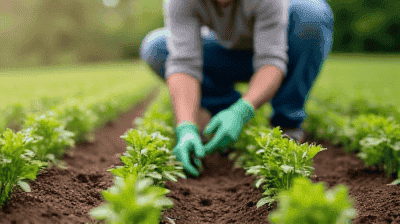
Sustainable agriculture has become a crucial topic in the face of climate change, biodiversity loss, and declining soil health. Conventional farming practices have often prioritized short-term yields over the long-term health of the environment, leading to soil depletion, increased greenhouse gas emissions, and reduced nutritional quality of food. In response to these pressing issues, regenerative organic agriculture has emerged as a promising solution.
Regenerative organic agriculture is an integrated farming approach that aims to restore and enhance soil health, promote biodiversity, and create resilient ecosystems. Unlike traditional organic agriculture, which primarily focuses on avoiding synthetic inputs, regenerative practices actively seek to improve the health of the soil, water systems, and the surrounding environment.
Soil Health Restoration: The foundation of regenerative organic agriculture lies in restoring soil health through practices that enhance soil organic matter and promote microbial diversity.
Biodiversity Promotion: Regenerative systems encourage the cultivation of diverse crops, which fosters natural pest control and enhances soil resilience.
Agroecological Practices: This involves using ecological principles to design farming systems that are efficient, sustainable, and capable of adapting to changing environmental conditions.
Minimal Disturbance: Practices such as no-till farming or reduced tillage help maintain soil structure and prevent erosion, allowing for healthier soils and crops.
Animal Integration: Incorporating livestock into farming systems can improve nutrient cycling and soil fertility through natural grazing patterns and manure application.
Community Engagement: Regenerative organic agriculture emphasizes the importance of local food systems and community involvement, promoting a deeper connection between consumers and producers.

Healthy soil is essential for sustainable food production and environmental health. Unfortunately, industrial agricultural practices have led to widespread soil degradation. Understanding how regenerative organic agriculture contributes to soil healing is key to realizing its benefits.
Soil is not merely a growing medium; it is a complex ecosystem that houses billions of microorganisms, fungi, and insects. These organisms carry out essential functions that support plant growth and contribute to overall ecosystem health. Healthy soils can:
Soil degradation occurs due to various factors, including erosion, compaction, loss of organic matter, and contamination from chemicals. These processes can lead to decreased fertility, increased runoff, and reduced biodiversity. The consequences of soil degradation are far-reaching:
Reduced Crop Yields: Fertile soil is essential for productive agriculture. Degraded soils produce lower yields, threatening food security.
Water Quality Issues: Eroded and compacted soils can contribute to runoff, carrying pollutants into waterways and harming aquatic ecosystems.
Climate Change: Healthy soils play a critical role in carbon sequestration. Degraded soils release carbon dioxide, exacerbating climate change.
Regenerative organic agriculture employs a variety of practices that contribute to soil health. Here are some key methods used in the process:
Cover crops are plants grown during the offseason to protect and enrich the soil. They prevent erosion, suppress weeds, and improve soil structure. Additionally, cover crops like legumes fix nitrogen in the soil, enhancing fertility.
Composting organic waste creates nutrient-rich soil amendments that can improve soil structure, enhance microbial activity, and increase organic matter content. This process recycles nutrients and reduces waste.
Diversity in crop rotation helps break pest and disease cycles, improves soil structure, and enhances nutrient availability. Rotating different crops can increase resilience and productivity.
Minimizing soil disturbance through reduced or no-till practices helps preserve soil structure and supports the microbial community. This method also reduces erosion and improves water infiltration.
Integrating trees into agricultural systems, known as agroforestry, provides multiple benefits. Trees enhance biodiversity, improve soil health, and contribute to carbon sequestration, all while providing shade and habitat for various species.

Beyond healing the soil, regenerative organic agriculture is designed to produce nutritious food that supports human health. The link between healthy soils and nutritional quality of crops is well established.
Healthy soils contribute to the nutrient content of crops. Research indicates that organically grown produce often contains higher levels of vitamins, minerals, and antioxidants compared to conventionally grown varieties. This is largely due to the practices that enhance soil health and biodiversity.
Crops grown in rich, diverse environments tend to have better flavors. The balance of nutrients in the soil influences the taste and quality of fruits and vegetables. Consumers increasingly seek out flavor-rich produce, driving demand for products from regenerative systems.
By relying on natural fertilizers and pest management strategies, regenerative organic agriculture minimizes the use of synthetic chemicals, resulting in food with lower levels of harmful residues. Consumers are more health-conscious and are actively seeking out organic and chemical-free foods.
Transitioning to regenerative organic agriculture offers numerous economic advantages for farmers and rural communities:
As consumer demand for sustainable and organic products continues to rise, regenerative organic farms can tap into lucrative markets. Certification as organic or regenerative can enhance market competitiveness, allowing farmers to command higher prices for their products.
Regenerative practices such as composting, cover cropping, and rotational grazing can reduce input costs in the long run. By decreasing reliance on synthetic fertilizers and pesticides, farmers can save money over time while improving soil health and productivity.
Diverse farming systems are more resilient to market and climate fluctuations. By growing a variety of crops and integrating livestock, farmers can adapt to changes in consumer demand and environmental conditions, reducing financial risk.
Regenerative organic agriculture creates job opportunities in rural communities, supporting local economies. Additionally, these practices foster community engagement and promote strong relationships between producers and consumers.

Despite the clear benefits of regenerative organic agriculture, several challenges must be addressed for widespread adoption:
There is a need for increased education and training around regenerative practices. Farmers, agricultural professionals, and consumers require access to information and resources to effectively implement these methods.
Policies that promote sustainable farming practices, provide financial assistance for transitioning, and support research into regenerative agriculture are essential. Advocacy for government support can help facilitate this transition.
Small-scale regenerative farmers may face challenges in accessing markets, especially if they lack connections to local distributors or consumers. Building cooperative networks can enhance market access and strengthen community ties.
Transitioning to regenerative practices may require an initial investment in terms of time, education, and resources. Farmers might need financial support during this transition phase to encourage long-term sustainability.
Many farmers around the world have successfully adopted regenerative organic agriculture practices, transforming their operations and contributing to environmental health and community well-being. Here are a few examples:
Located in Pennsylvania, the Rodale Institute is a pioneer in regenerative organic agriculture research. Their studies demonstrate the benefits of organic practices on soil health and crop yields, providing valuable information for farmers seeking to transition.
Polyface Farm in Virginia is known for its innovative pastured livestock practices. The farm integrates chickens, pigs, and cattle in a rotational grazing system that enhances soil health while producing high-quality meat and eggs.
Kiss the Ground is a nonprofit organization that advocates for regenerative agriculture and its potential to combat climate change. Through educational programs and community engagement, they promote the importance of regenerative practices and support farmers in implementing these methods.
As we face an uncertain future with climate change and growing food insecurity, regenerative organic agriculture provides a viable path towards a sustainable food system. Through concerted efforts at the individual, community, and policy levels, we can harness the power of regenerative practices to heal our soils and produce nutritious food for generations to come.
Regenerative organic agriculture offers a holistic approach to food production that prioritizes soil health, biodiversity, and community well-being. By embracing these practices, we can heal the land while ensuring a reliable supply of nutritious food. As consumers increasingly recognize the importance of sustainable agriculture, we have an opportunity to reshape food systems for the better.
Investing in regenerative organic agriculture is not just an environmental imperative; it is a commitment to healthier soils, healthier foods, and healthier communities.